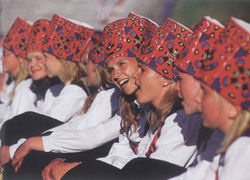Although it is a simplification, Estonians divide their own history into four periods – Polish, Swedish, and Russian rule and independence. As a joke they often say that times under Swedish rule were the best, and since history likes to repeat itself, they look with hope upon its new chapter beginning now – accession to the European Union.

Girls in national costumes,
photo Tomasz Tomaszewski
When we speak about the Baltic nations, we often think of Lithuania, Latvia, and Estonia together. However it is rare that we can say anything concrete about the differences between those countries. Especially Estonia, maybe because it is the farthest away and the smallest, presents itself as the periphery, the margin of not only Europe but also of this region. It is quite different from the perspective of the average Estonian, for whom the matter of distinctiveness and exceptionality of his country is as obvious, as the fact that it is located in… the center of Europe.
Many centuries of Russian domination did not change the fact, that Estonians think of themselves as Scandinavians. Apart from the closeness of the Estonian and Finnish languages, this is evidenced by the similarities in folk ceremonies, rural architecture monuments, traditional cuisine (although there are also some specialties well – known to us such as black pudding and brawn). Also the characteristics of the average Estonian are quite similar to those of a Swede or a Norwegian. Upon first meeting them, Estonians may seem withdrawn, reserved, and too organized. However true Scandinavian fondness for organized social life, where group affiliation is sometimes more important than individual desires, doesn’t stop the Estonians from living and enjoying that, which is made possible by new conditions, cultivating tradition, and at the same time consciously building a new country.
The Estonians have bet on a modern civic state. Some studies call this country “the tiger of the Baltic”, and there is no exaggeration it that. In 2003 1.2% of the state budget was allocated to the development of informational technologies – almost as much as to defense. It has been like this for 10 years and the effects are apparent. In a study conducted by Mac Connell International, which takes into consideration internet usage, security of services and government commitment, in 53 developing countries Estonia was ranked the highest together with South Korea. In Estonia it is already possible to take care of all administrative business electronically and 80% of banking operations are also conducted in this way.
When it comes to this matter Estonia is even ahead of some European Union countries. Low income tax rates for firms, and quite cheap labor force, have made conditions favorable for the inflow of foreign capital, and low prices have drawn tourists. It is especially visible on the streets of Tallinn. In recent years Estonia has been visited by 3 million tourists a year, mainly from Germany and Finland.
Tallinn is only 80 kilometers from Helsinki. Over 20 ferries, mainly from Finland, arrive daily at the Tallinn harbor. The Finns are loud, visible, and conscious of their importance. The locals treat them with a slight indulgence and call them “Finnish moose” but they know very well, that thanks to them, for whom the main tourist attractions are the local prices, a large amount of people has a job. It is for them that there are vendors on the street, offering hand – crafted goods – sweaters, socks, hats. They are just as good and just as pretty as Norwegian goods but three times as cheap. Even during the times of Soviet Union, Estonia always looked towards the Baltic Sea. It is here, that contacts with the West were the easiest. In Finnish television, picked up by regular house antennas, Estonians could see what life was like in Europe. Now Europe has come knocking and they are ready.
This text was published thanks to National Geographic Polska. The text can be used only with the permission of the authors. Photographs published with permission of the authors.
Translator: Szczepan Witaszek









